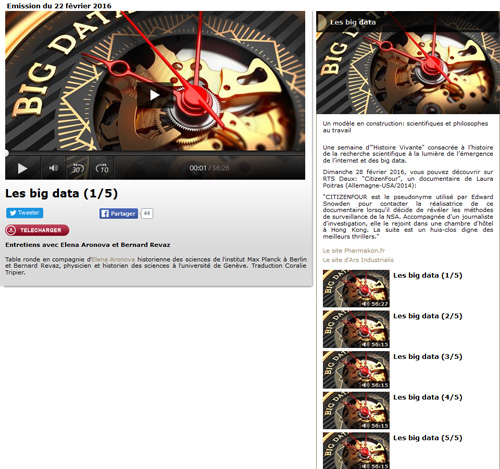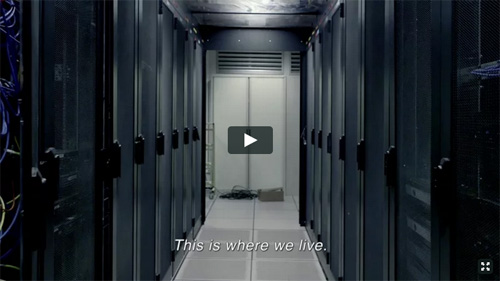Sticky Postings
All 242 fabric | rblg updated tags | #fabric|ch #wandering #reading
By fabric | ch
-----
As we continue to lack a decent search engine on this blog and as we don't use a "tag cloud" ... This post could help navigate through the updated content on | rblg (as of 09.2023), via all its tags!
FIND BELOW ALL THE TAGS THAT CAN BE USED TO NAVIGATE IN THE CONTENTS OF | RBLG BLOG:
(to be seen just below if you're navigating on the blog's html pages or here for rss readers)
--
Note that we had to hit the "pause" button on our reblogging activities a while ago (mainly because we ran out of time, but also because we received complaints from a major image stock company about some images that were displayed on | rblg, an activity that we felt was still "fair use" - we've never made any money or advertised on this site).
Nevertheless, we continue to publish from time to time information on the activities of fabric | ch, or content directly related to its work (documentation).
Wednesday, November 30. 2022
Atomized (re-)Staging, new work by fabric | ch on @beyondmatter and @zkm | #exhibition #digital #autonomous
Via
-----
Wednesday, January 26. 2022
Platform of Future-Past (2022) at HOW Art Museum in Shanghai | #data #monitering #installation
Note:
The exhibition Beneath the Skin, Between the Machines just opened at HOW Art Museum (Hao Art Gallery) and fabric | ch was keen to be invited to create a large installation for the show, also intented to be used during a symposium that will be entirely part of the exhibition (panels and talks as part of the installation therefore). The exhibition will be open between January 15 - April 24 2022 in Shanghai.
Along with a selection of chinese and international artists, curator Liaoliao Fu asked us to develop a proposal based on a former architectural device, Public Platform of Future-Past, which in itself was inspired by an older installation of ours... Heterochrony.
This new work, entitled Platform of Future-Past, deals with the temporal oddity that can be produced and induced by the recording, accumulation and storage of monitoring data, which contributes to leaving partial traces of "reality", functioning as spectres of the past.
We are proud to present this work along artists such as Hito Steyerl, Geumhyung Jeong, Lu Yang, Jon Rafman, Forensic Architecture, Lynn Hershman Leeson and Harun Farocki.
...
Last but not least and somehow a "sign of the times", this is the first exhibition in which we are participating and whose main financial backers are a blockchain and crypto-finance company, as well as a NFT platform. Both based in China.
More information about the symposium will be published.
Via Pro Helvetia
-----

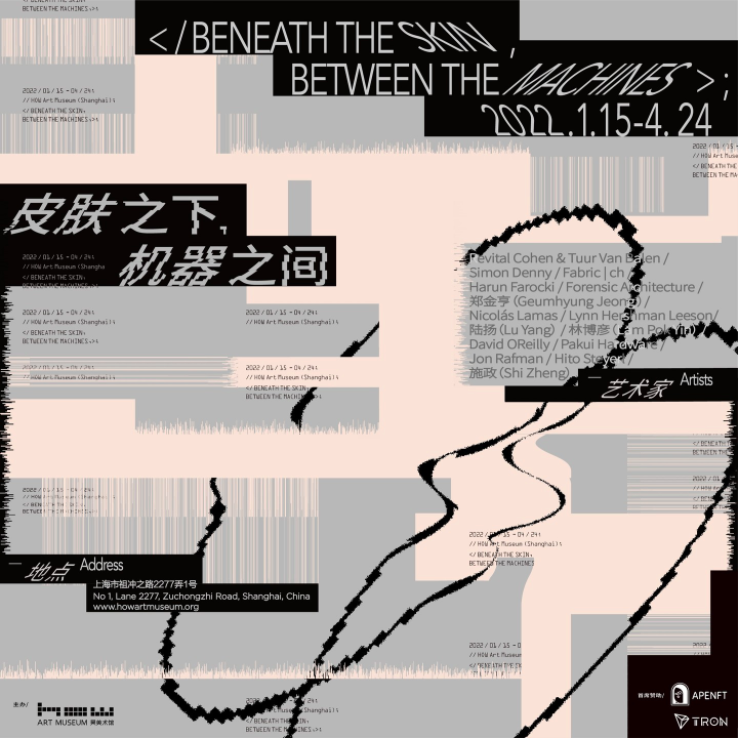
-----
Curatorial Statement
By Fu Liaoliao and the curatorial team
"Man is only man at the surface. Remove the skin, dissect, and immediately you come to machinery.” When Paul Valéry wrote this down, he might not foresee that human beings – a biological organism – would indeed be incorporated into machinery at such a profound level in a highly informationized and computerized time and space. In a sense, it is just as what Marx predicted: a conscious connection of machine[1]. Today, machine is no longer confined to any material form; instead, it presents itself in the forms of data, coding and algorithm – virtually everything that is “operable”, “calculable” and “thinkable”. Ever since the idea of cyborg emerges, the man-machine relation has always been intertwined with our imagination, vision and fear of the past, present and future.
In a sense, machine represents a projection of human beings. We human beings transfer ideas of slavery and freedom to other beings, namely a machine that could replace human beings as technical entities or tools. Opposite (and similar, in a sense,) to the “embodiment” of machine, organic beings such as human beings are hurrying to move towards “disembodiment”. Everything pertinent to our body and behavior can be captured and calculated as data. In the meantime, the social system that human beings have created never stops absorbing new technologies. During the process of trial and error, the difference and fortuity accompanying the “new” are taken in and internalized by the system. “Every accident, every impulse, every error is productive (of the social system),”[2] and hence is predictable and calculable. Within such a system, differences tend to be obfuscated and erased, but meanwhile due to highly professional complexities embedded in different disciplines/fields, genuine interdisciplinary communication is becoming increasingly difficult, if not impossible.
As a result, technologies today are highly centralized, homogenized, sophisticated and commonized. They penetrate deeply into our skin, but beyond knowing, sensing and thinking. On the one hand, the exhibition probes into the reconfiguration of man by technologies through what’s “beneath the skin”; and on the other, encourages people to rethink the position and situation we’re in under this context through what’s “between the machines”. As an art institute located at Shanghai Zhangjiang Hi-Tech Industrial Development Zone, one of the most important hi-tech parks in China, HOW Art Museum intends to carve out an open rather than enclosed field through the exhibition, inviting the public to immerse themselves and ponder upon the questions such as “How people touch machines?”, “What the machines think of us?” and “Where to position art and its practice in the face of the overwhelming presence of technology and the intricate technological reality?”
Departing from these issues, the exhibition presents a selection of recent works of Revital Cohen & Tuur Van Balen, Simon Denny, Harun Farocki, Nicolás Lamas, Lynn Hershman Leeson, Lu Yang, Lam Pok Yin, David OReilly, Pakui Hardware, Jon Rafman, Hito Steyerl, Shi Zheng and Geumhyung Jeong. In the meantime, it intends to set up a “panel installation”, specially created by fabric | ch for this exhibition, trying to offer a space and occasion for decentralized observation and participation in the above discussions. Conversations and actions are to be activated as well as captured, observed and archived at the same time.
[1] Karl Marx, “Fragment on Machines”, Foundations of a Critique of Political Economy
[2] Niklas Luhmann, Social Systems
-----
Schedule
Duration: January 15-April 24, 2022
Artists: Revital Cohen & Tuur Van Balen, Simon Denny, fabric | ch, Harun Farocki, Geumhyung Jeong, Nicolás Lamas, Lynn Hershman Leeson, Lu Yang, Lam Pok Yin, David OReilly, Pakui Hardware, Jon Rafman, Hito Steyerl, Shi Zheng
Curator: Fu Liaoliao
Organizer: HOW Art Museum, Shanghai
Lead Sponsor: APENFT Foundation
Swiss participation is supported by Pro Helvetia Shanghai, Swiss Arts Council.
(Swiss speakers and performers appearing in the educational events will be updated soon.)
-----
Work by fabric | ch
HOW Art Museum has invited Lausanne-based artist group fabric | ch to set up a “panel installation” based on their former project “Public Platform of Future Past” and adapted to the museum space, fostering insightful communication among practitioners from different fields and the audiences.
“Platform of Future-Past” is a temporary environmental device that consists in a twenty meters long walkway, or rather an observation deck, almost archaeological: a platform that overlooks an exhibition space and that, paradoxically, directly links its entrance to its exit. It thus offers the possibility of crossing this space without really entering it and of becoming its observer, as from archaeological observation decks. The platform opens- up contrasting atmospheres and offers affordances or potential uses on the ground.
The peculiarity of the work consists thus in the fact that it generates a dual perception and a potential temporal disruption, which leads to the title of the work, Platform of Future-Past: if the present time of the exhibition space and its visitors is, in fact, the “archeology” to be observed from the platform, and hence a potential “past,” then the present time of the walkway could be understood as a possible “future” viewed from the ground…
“Platform of Future-Past” is equipped in three zones with environmental monitoring devices. The sensors record as much data as possible over time, generated by the continuously changing conditions, presences and uses in the exhibition space. The data is then stored on Platform Future-Past’s servers and replayed in a loop on its computers. It is a “recorded moment”, “frozen” on the data servers, that could potentially replay itself forever or is waiting for someone to reactivate it. A “data center” on the deck, with its set of interfaces and visualizations screens, lets the visitors-observers follow the ongoing process of recording.
The work could be seen as an architectural proposal built on the idea of massive data production from our environment. Every second, our world produces massive amounts of data, stored “forever” in remote data centers, like old gas bubbles trapped in millennial ice.
As such, the project is attempting to introduce doubt about its true nature: would it be possible, in fact, that what is observed from the platform is already a present recorded from the past? A phantom situation? A present regenerated from the data recorded during a scientific experiment that was left abandoned? Or perhaps replayed by the machine itself ? Could it already, in fact, be running on a loop for years?
Platform of Future-Past, Scaffolding, projection screens, sensors, data storage, data flows, plywood panels, textile partitions
-----
Platform of Future-Past (2022)



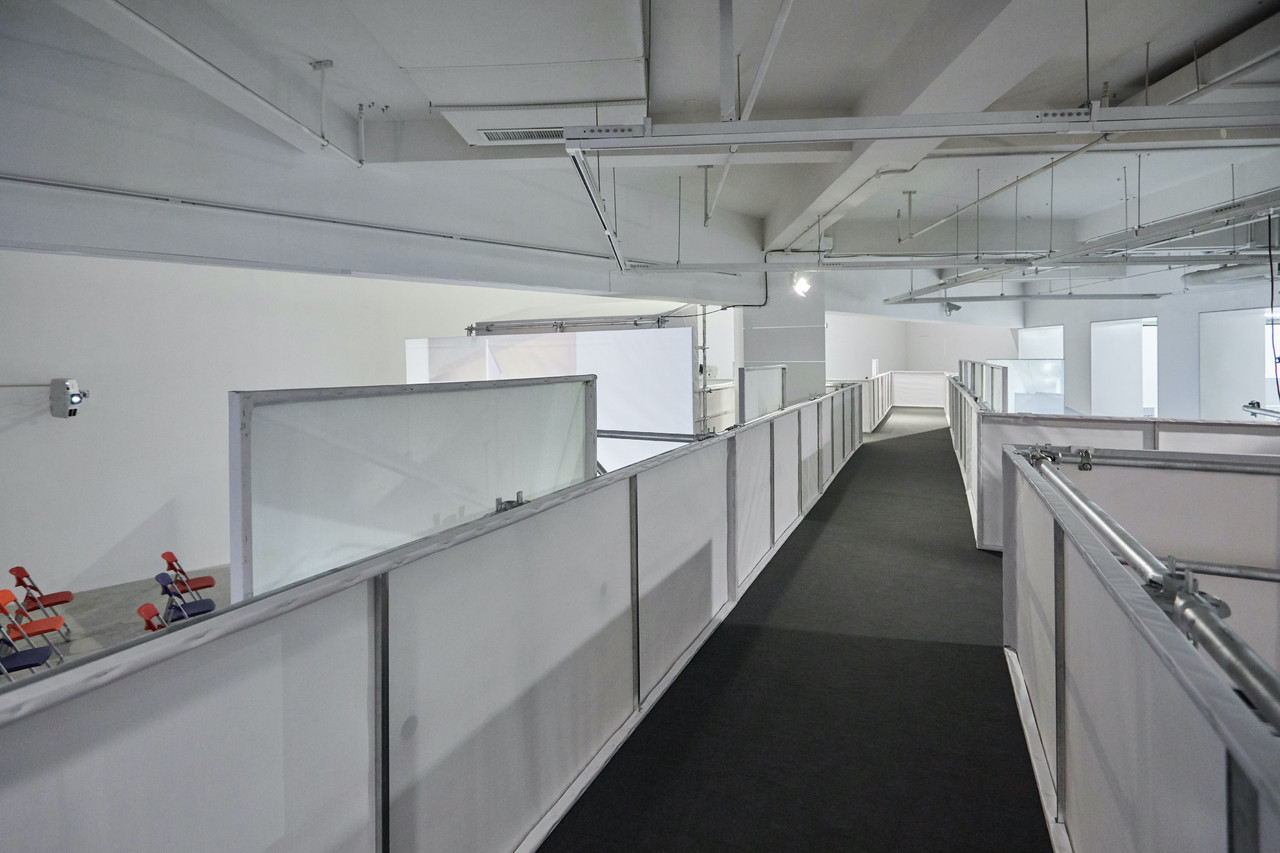
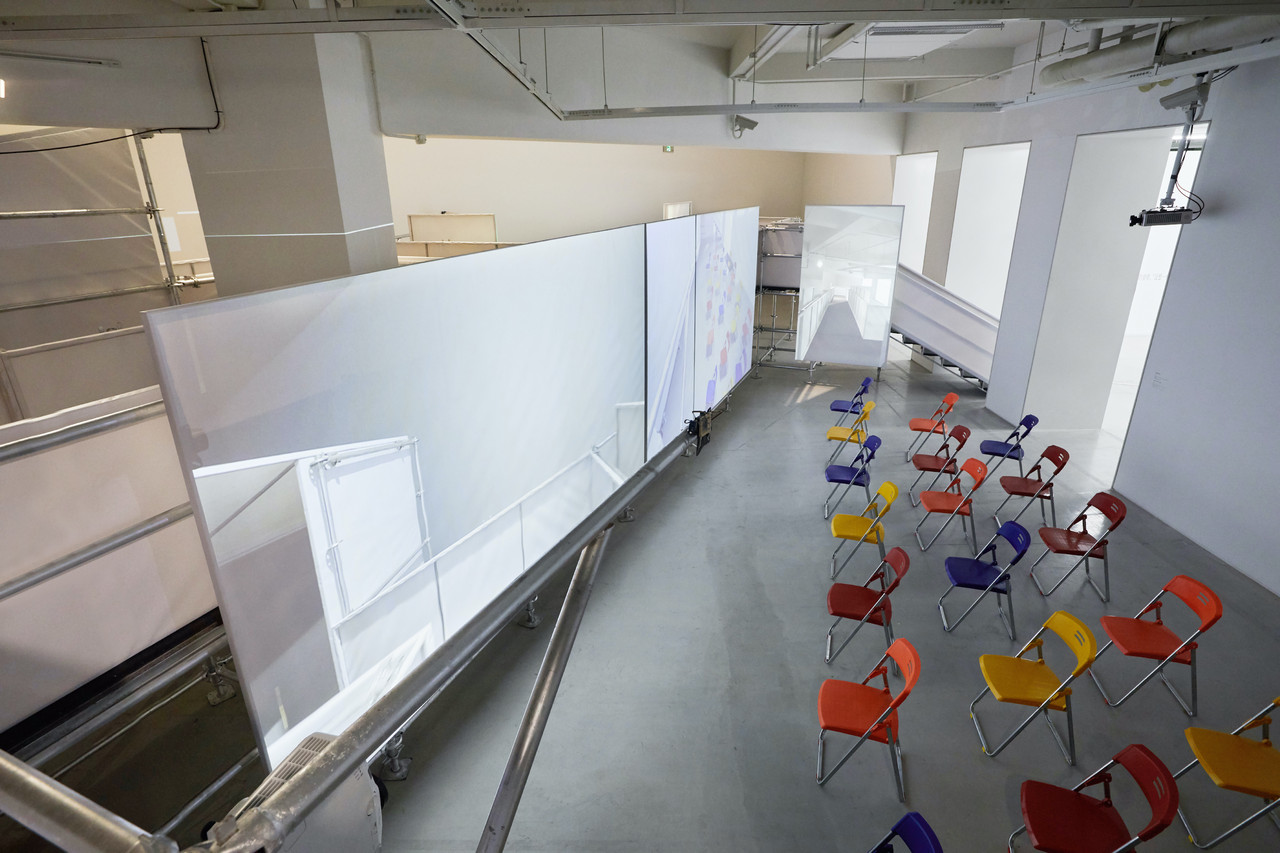


-----
Beneath the Skin, Between the Machines (exhibition, 01.22 - 04.22)
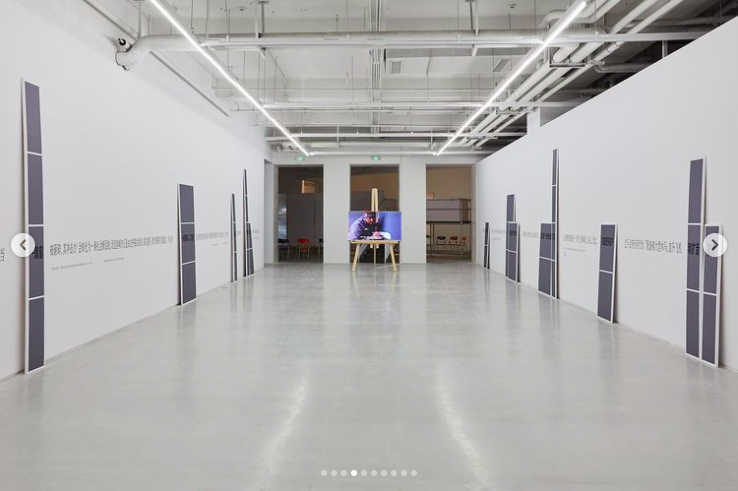
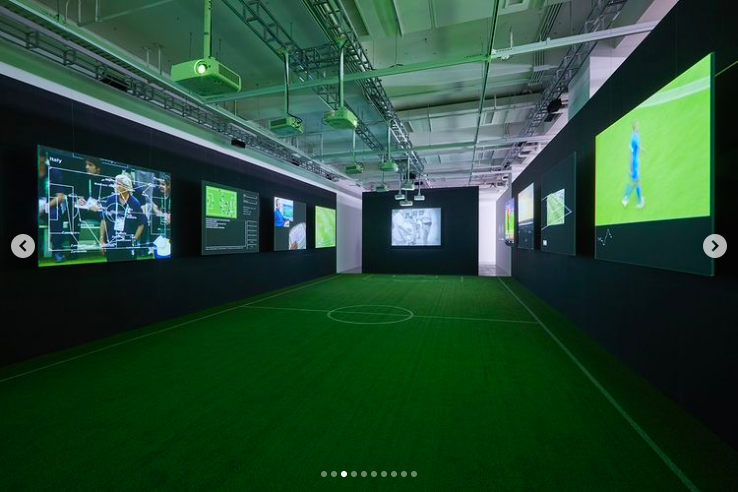

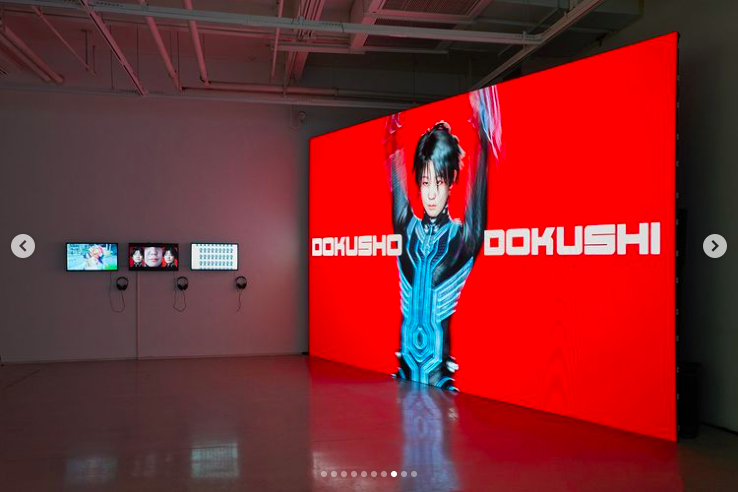
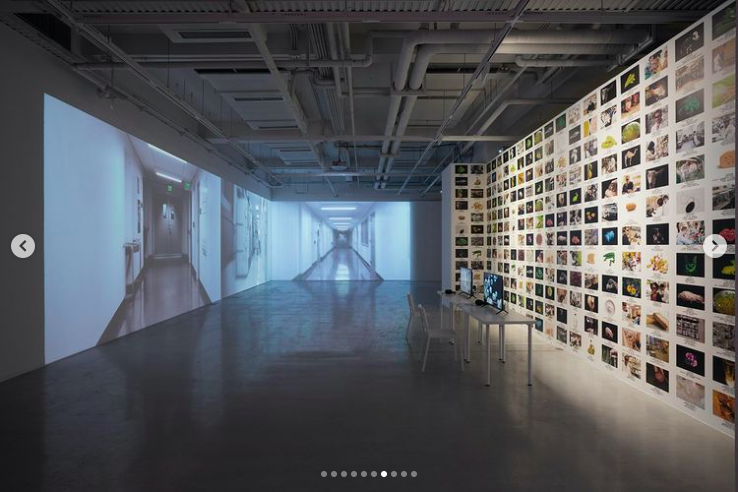
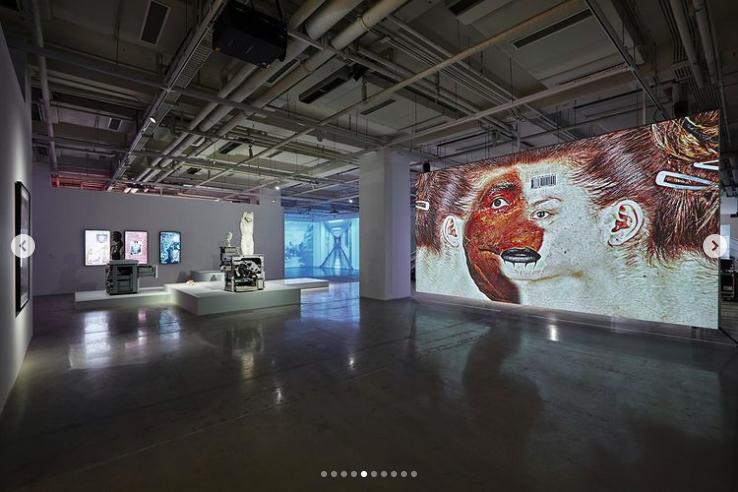

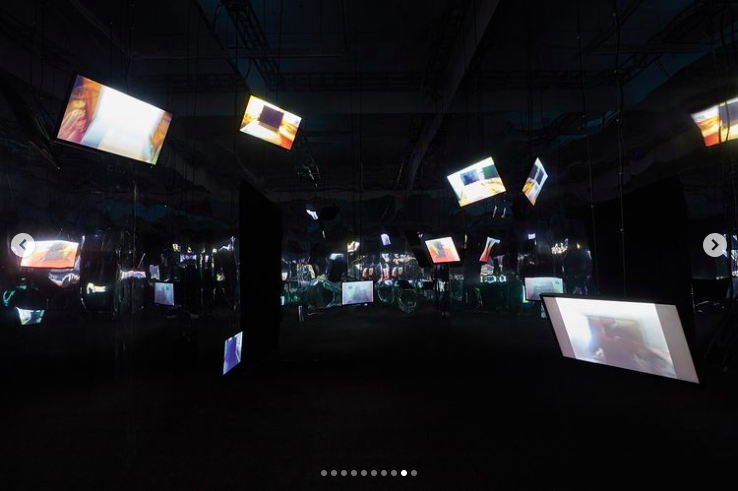

-----
Platform of Future-Past was realized with the support of Pro Helvetia.
Thursday, November 22. 2018
Programmed: Rules, Codes, and Choreographies in Art, 1965–2018 | #algorithms #creation
Note: open since last September and seen here and there, this exhibition at the Withney about the uses of rules and code in art. It follows a similar exhibition - and historical as well - this year at the MOMA, Thinking Machines. This certainly demonstrates an increasing desire and interest in the historization of six decades - five in the context of this show - of "art & technologies" (not yet "design & technologies", while "architecture and digital" was done at the CCA).
Those six decades remained almost under the radar for long and there will be obviously a lot of work to do to write this epic!
Interesting in the context of the Whitney exhibition are the many sub-topics developed:
- Rule, Instruction, Algorithm: Ideas as Form /
- Rule, Instruction, Algorithm: Generative Measures /
- Rule, Instruction, Algorithm: Collapsing Instruction and Form /
- Signal, Sequence, Resolution: Image Resequenced /
- Signal, Sequence, Resolution: Liberating the Signal /
- Signal, Sequence, Resolution: Realities Encoded /
- Augmented Reality: Tamiko Thiel
Via Whitney Museum of American Art
-----
.jpg)
Programmed: Rules, Codes, and Choreographies in Art, 1965–2018 establishes connections between works of art based on instructions, spanning over fifty years of conceptual, video, and computational art. The pieces in the exhibition are all “programmed” using instructions, sets of rules, and code, but they also address the use of programming in their creation. The exhibition links two strands of artistic exploration: the first examines the program as instructions, rules, and algorithms with a focus on conceptual art practices and their emphasis on ideas as the driving force behind the art; the second strand engages with the use of instructions and algorithms to manipulate the TV program, its apparatus, and signals or image sequences. Featuring works drawn from the Whitney’s collection, Programmed looks back at predecessors of computational art and shows how the ideas addressed in those earlier works have evolved in contemporary artistic practices. At a time when our world is increasingly driven by automated systems, Programmed traces how rules and instructions in art have both responded to and been shaped by technologies, resulting in profound changes to our image culture.
The exhibition is organized by Christiane Paul, Adjunct Curator of Digital Art, and Carol Mancusi-Ungaro, Melva Bucksbaum Associate Director for Conservation and Research, with Clémence White, curatorial assistant.
Friday, July 13. 2018
Thinking Machines at MOMA | #computing #art&design&architecture #history #avantgarde
Note: following the exhibition Thinking Machines: Art and Design in the Computer Age, 1959–1989 until last April at MOMA, images of the show appeared on the museum's website, with many references to projects. After Archeology of the Digital at CCA in Montreal between 2013-17, this is another good contribution to the history of the field and to the intricate relations between art, design, architecture and computing.
How cultural fields contributed to the shaping of this "mass stacked media" that is now built upon the combinations of computing machines, networks, interfaces, services, data, data centers, people, crowds, etc. is certainly largely underestimated.
Literature start to emerge, but it will take time to uncover what remained "out of the radars" for a very long period. They acted in fact as some sort of "avant-garde", not well estimated or identified enough, even by specialized institutions and at a time when the name "avant-garde" almost became a "s-word"... or was considered "dead".
Unfortunately, no publication seems to have been published in relation to the exhibition, on the contrary to the one at CCA, which is accompanied by two well documented books.
Via MOMA
-----
Thinking Machines: Art and Design in the Computer Age, 1959–1989
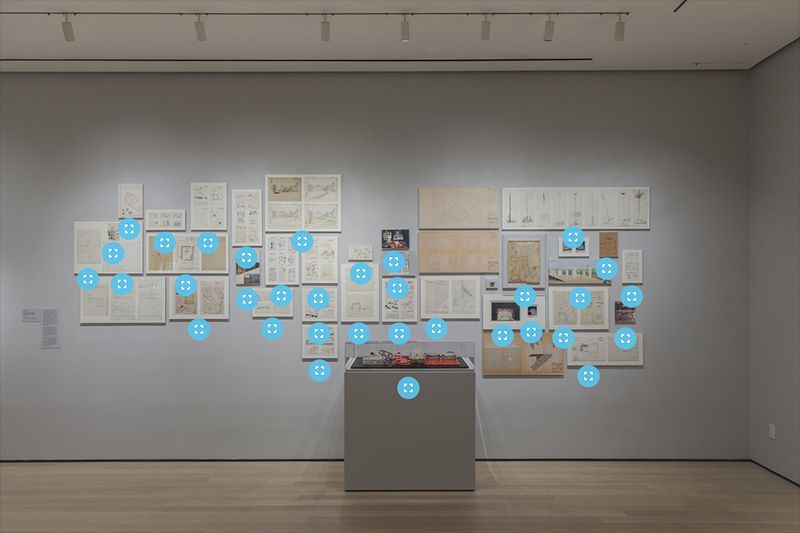
November 13, 2017–
Drawn primarily from MoMA's collection, Thinking Machines: Art and Design in the Computer Age, 1959–1989 brings artworks produced using computers and computational thinking together with notable examples of computer and component design. The exhibition reveals how artists, architects, and designers operating at the vanguard of art and technology deployed computing as a means to reconsider artistic production. The artists featured in Thinking Machines exploited the potential of emerging technologies by inventing systems wholesale or by partnering with institutions and corporations that provided access to cutting-edge machines. They channeled the promise of computing into kinetic sculpture, plotter drawing, computer animation, and video installation. Photographers and architects likewise recognized these technologies' capacity to reconfigure human communities and the built environment.
Thinking Machines includes works by John Cage and Lejaren Hiller, Waldemar Cordeiro, Charles Csuri, Richard Hamilton, Alison Knowles, Beryl Korot, Vera Molnár, Cedric Price, and Stan VanDerBeek, alongside computers designed by Tamiko Thiel and others at Thinking Machines Corporation, IBM, Olivetti, and Apple Computer. The exhibition combines artworks, design objects, and architectural proposals to trace how computers transformed aesthetics and hierarchies, revealing how these thinking machines reshaped art making, working life, and social connections.
Organized by Sean Anderson, Associate Curator, Department of Architecture and Design, and Giampaolo Bianconi, Curatorial Assistant, Department of Media and Performance Art.
-
More images HERE.
Wednesday, February 24. 2016
(Big) Data sur la RTS, RTS website (Lausanne, 2016) | #entretien #détournements
Note: j'aurai le plaisir d'être en entretien --en français-- ce vendredi 26.02 à 20h avec le journaliste Frédéric Pfyffer, de la Radio Télévision Suisse Romande, dans le cadre du programme Histoire Vivante qui traite cette semaine du sujet des "Big Data".
Cet entretien, qui a été enregistré en fin de semaine passée, nous verra évoquer la façon dont les artistes ou designers abordent aujourd'hui --mais aussi un peu hier-- cette question des données. En contrepoint ou complément peut-être des approches scientifiques. Pour ma part, aussi bien dans le contexte de ma pratique indépendante (fabric | ch où de nombreux projets réalisés ou en développement s'appuient sur des données) qu'académique (projet de recherche interdisciplinaire en cours autour des "nuages"... entre autres).
À noter encore qu'au terme de la semaine d'émissions thématiques sera diffusé sur la TSR (dimanche 28.02) le documentaire Citizenfour, qui relate toute l'aventure d'Edward Snowden et du journaliste Glenn Greenwald.
Ces cinq émissions seront également disponibles en mode podcast à la même adresse, suite à la diffusion de cette semaine.
Via RTS
-----
Une semaine d’Histoire Vivante consacrée à l’histoire de la recherche scientifique à la lumière de l’émergence de l’internet et des big data.
-
Dimanche 28 février 2016, vous pouvez découvrir sur RTS Deux: CitizenFour, un documentaire de Laura Poitras (Allemagne-USA/2014):
"Citizenfour est le pseudonyme utilisé par Edward Snowden pour contacter la réalisatrice de ce documentaire lorsqu'il décide de révéler les méthodes de surveillance de la NSA. Accompagnée d'un journaliste d'investigation, elle le rejoint dans une chambre d'hôtel à Hong Kong. La suite est un huis-clos digne des meilleurs thrillers."
Wednesday, July 29. 2015
Creating Radical Software: A Personal Account | #magazine #history #media
Note: after the recent post about E.A.T. and while we are into history, here is also an intersting article by Phyllis (Gershuny) Segura, one of the founders of the 1970's journal Radical Software, where she explains the birth and motivatiosn behind the magazine. It was a journal about the then very young video art, but exceeded this thematic by far, including avant-garde thematics such as cybernetic, information theory or networks.
Via Rhizome
-----
Creating Radical Software: A Personal Account
By Phyllis (Gershuny) Segura
What can be analyzed in my work, or criticized, are the questions that I ask…my composition arises out of asking questions.
— John Cage
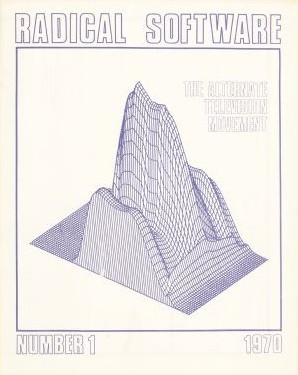
Radical Software Volume I, Number 1: the Alternate Television Movement (Spring 1970)
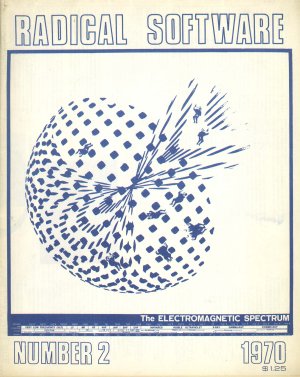
Radical Software Volume I, Number 2: the Electromagnetic Spectrum (Autumn 1970).
As rare as it is for something to be an instant success, this is what happened with Radical Software, a journal started in 1970 to bring a fresh direction to communication via personal and portable video equipment and other cybernetic explorations. Its intention was to foster an alternative to broadcast media and lessen the impact of its control. I was the co-founder.
When I began conceiving of the journal, no one really knew precisely what I was getting at because my ideas about it were at an inchoate stage of development, making for loose coherency. The idea was for individuals to be able to communicate interactively without the filters of broadcast media. Even at a more formalized stage the process superseded any formulaic views. Perhaps asking non-hierarchical questions could materialize the structures leading to a two-way network for communicative exchange. Our choices were no longer determined by traditions and customs.
I don't often look, but when I do, I notice so much misinformation, both printed and online, about the origins of Radical Software. I‘d like to clarify what my role was then and what my inspiration was in conceiving of it. It is important to set the background and tone of events. In order to accurately tell the tale I will weave in some personal life anecdotes from the time. It's all one story to me, as the vicissitudes of life often direct our fates.
“Those were the underlying circumstances that led to Radical Software: curiosity and confinement.”
(...)
Read more about it HERE.
Related Links:
Wednesday, February 18. 2015
World Brain: a journey through data centers | #data #dimensions
Via iiclouds.org (Nicolas Nova)
-----
“World Brain” by Stéphane Degoutin and Gwenola Wagon (2015):
World Brain proposes a stroll through motley folkloric tales : data centers, animal magnetism, the Internet as a myth, the inner lives of rats, how to gather a network of researchers in the forest, how to survive in the wild using Wikipedia, how to connect cats and stones…
The world we live in often resembles a Borgesian story. Indeed, if one wanted to write a sequel to Borges’ Fictions, he could do it simply by putting together press articles.
The World Brain is made out mostly of found materials : videos downloaded on Youtube, images, scientific or pseudo scientific reports, news feeds… [...] World Brain takes the viewer through a journey inside the physical places by which the Internet transits: submarine cables, data centers, satellites. The film adopts the point of view of the data. The audience view the world as if they were information, crossing the planet in an instant, copied in an infinite number of instances or, at the contrary, stored in secret places.
Thursday, November 13. 2014
Design research: I&IC - Inhabiting & Interfacing the Clouds | #datacenter #cloud #infrastructure
By fabric | ch
-----
I'm very happy to write that after several months of preparation, I'm leading a new design-research (that follows Variable Environment, dating back from 2007!) for the University of Art & design, Lausanne (ECAL), in partnership with Nicolas Nova (HEAD). The project will see the transversal collaboration of architects, interaction designers, ethnographers and scientists with the aim of re-investigating "cloud computing" and its infrastructures from a different point of view. The name of the project: Inhabiting and Interfacing the Cloud(s), which is now online under the form of a blog that will document our progresses. The project should last until 2016.
The main research team is composed of:
Patrick Keller, co-head (Prof. ECAL M&ID, fabric | ch) / Nicolas Nova, co-head (Prof. HEAD MD, Near Future Laboratory) / Christophe Guignard (Prof. ECAL M&ID, fabric | ch) / Lucien Langton (assistant ECAL M&ID) / Charles Chalas (assistant HEAD MD) / Dieter Dietz (Prof. EPFL - Alice) & Caroline Dionne (Post-doc EPFL - Alice) / Dr. Christian Babski (fabric | ch).
I&IC Workshops with students from the HEAD, ECAL (interaction design) and EPFL (architecture) will be conducted by:
James Auger (Prof. RCA, Auger - Loizeau) / Matthew Plummer-Fernandez (Visiting Tutor Goldsmiths College, Algopop) / Thomas Favre - Bulle (Lecturer EPFL).
Finally, a group of "advisors" will keep an eye on us and the research artifacts we may produce:
Babak Falsafi (Prof. EPFL - Ecocloud) / Prof. Zhang Ga (TASML, Tsinghua University) / Dan Hill (City of Sound, Future Cities Catapult) / Ludger Hovestadt (Prof. ETHZ - CAAD) / Geoff Manaugh (BLDGBLOG, Gizmodo).
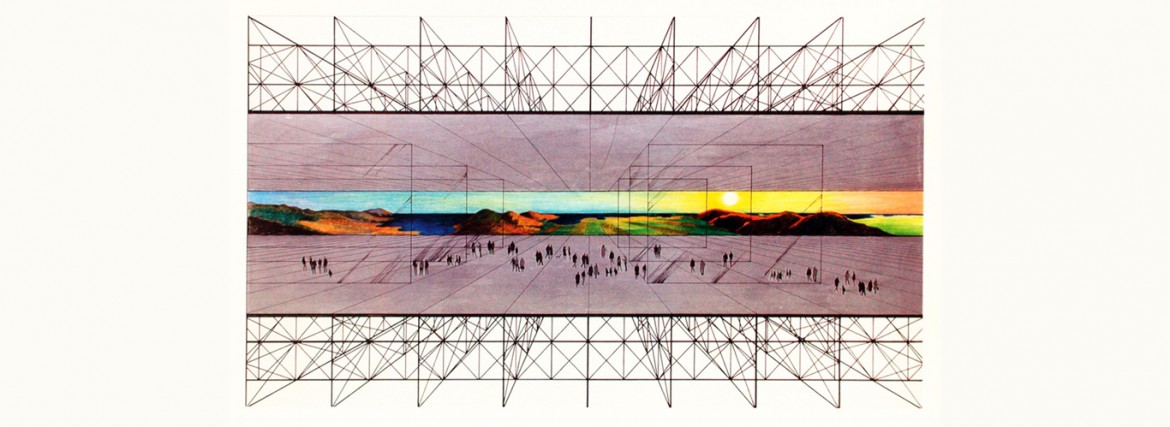
Andrea Branzi, 1969, Research for "No-Stop City".
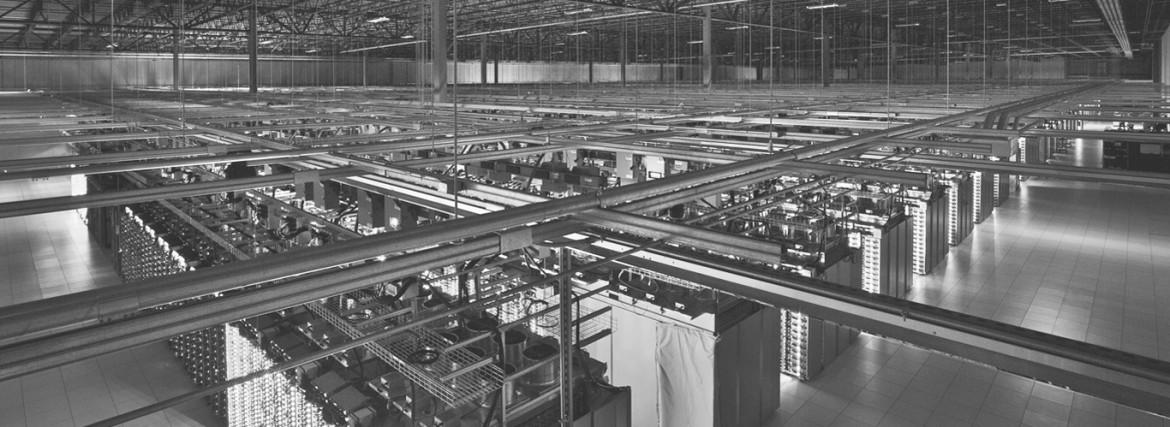
Google data center in Lenoir, North Carolina (USA), 2013.
As stated on the I&IC webiste:
The design research I&IC (Inhabiting and Interfacing the Clouds), explores the creation of counter-proposals to the current expression of “Cloud Computing”, particularly in its forms intended for private individuals and end users (“Personal Cloud”). It is led by Profs. Patrick Keller (ECAL) and Nicolas Nova (HEAD) and is documented online as a work in progress, 2014-2017.
I&IC is to offer an alternative point of view, a critical appraisal as well as to provide an “access to tools” about this iconic infrastructure of our modernity and its user interfaces, because to date their implementation has followed a logic chiefly of technical development, mainly governed by corporate interests, and continues therefore to be paradoxically envisioned as a purely functional, centralized setup.
However, the Personal Cloud holds a potential that is largely untapped in terms of design, novel uses and territorial strategies. Through its cross-disciplinary approach that links interaction design, the architectural and territorial dimensions as well as ethnographic studies, our project aims at producing alternative models resulting from a more contemporary approach, notably factoring in the idea of creolization (theorized by E. Glissant).
Related Links:
Thursday, April 03. 2014
Snowden's mediated mobility | #tele-
fabric | rblg
This blog is the survey website of fabric | ch - studio for architecture, interaction and research.
We curate and reblog articles, researches, writings, exhibitions and projects that we notice and find interesting during our everyday practice and readings.
Most articles concern the intertwined fields of architecture, territory, art, interaction design, thinking and science. From time to time, we also publish documentation about our own work and research, immersed among these related resources and inspirations.
This website is used by fabric | ch as archive, references and resources. It is shared with all those interested in the same topics as we are, in the hope that they will also find valuable references and content in it.
Quicksearch
Categories
Calendar
|
|
April '24 | |||||
| Mon | Tue | Wed | Thu | Fri | Sat | Sun |
| 1 | 2 | 3 | 4 | 5 | 6 | 7 |
| 8 | 9 | 10 | 11 | 12 | 13 | 14 |
| 15 | 16 | 17 | 18 | 19 | 20 | 21 |
| 22 | 23 | 24 | 25 | 26 | 27 | 28 |
| 29 | 30 | |||||
